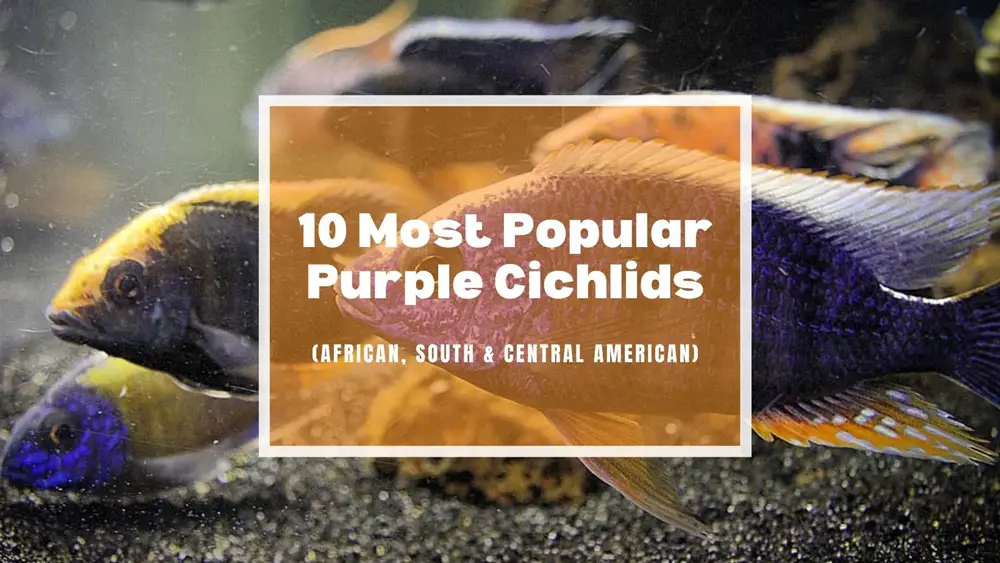I know, I know. Another cichlid post. But there are just so many beautiful cichlids out there, and I can’t help myself!
While there are countless colorful fish to choose from, we’ve decided to focus on one particular color group – purple cichlids. These striking fish come in many different shapes and sizes, making them perfect for any aquarium. Whether you’re looking for a unique centerpiece or a more subdued purple cichlid, we’ve got you covered.
So, if you’re interested in keeping some of these stunning fish, read on for a list of the best options. Who knows, maybe you’ll find your next dream fish.
Purple African Cichlid Species
All cichlid enthusiasts gravitate towards African cichlids at some point. And for a good reason – they’re absolutely beautiful. These purple African Mbunas and Peacocks typically require heavy stocked, so if you’re looking for a real showstopper, this is the way to go.
Yellow Tail Acei Cichlid (Pseudotropheus sp. “acei”)

The Yellow Tail Acei Cichlid is one of only a few beginner-friendly Mbunas, characterized by its pale purple body and bright yellow tail. Males have more vibrant purple coloration when breeding. Although it’s one of the most popular Mbunas in the aquarium scene, it has not been formally described.
Two naturally occurring color varieties are available, including:
- Yellow Tail Acei: Pseudotropheus sp. “Acei” (Msuli)
- White Tail Acei: Pseudotropheus sp. “Acei” (Ngara)
Unlike the most widespread Yellow Tail Acei, the White Tail Acei takes on a paler blue with white fins.
These fish not only stand out with their striking coloration but also their personalities. They are known to be some of the more peaceful Mbunas. You can keep them with other attractive species such as Electric Yellow labs (L. caeruleus), Red Top Hongi(Labidochromis sp. “Hongi”), and Rusty Cichlid (I. sprengerae) in a “most peaceful” Malawi aquarium.
| Scientific Name: | Pseudotropheus sp. “acei” |
| Common Name: | Acei Cichlid, Yellow-tail Acei, White-tail Acei |
| Care Level: | Beginner |
| IUCN Red List: | Least Concern |
| Origin: | Lake Malawi, African |
| Lifespan: | 8 – 10 years |
| Max Size: | 5 inches (12.7 cm) |
| Temperature: | 73.0 to 82.0° F (22.8 to 27.8° C) |
| PH: | 7.7–8.6 |
| Water hardness: | 10 to 25 KH |
| Diet: | Omnivorous |
| Minimum Tank Size: | 55 gallons (48″ x 13″ x 21″) |
| Temperament: | Relatively Peaceful |
Male Rusty Cichlid (Iodotropheus sprengerae)
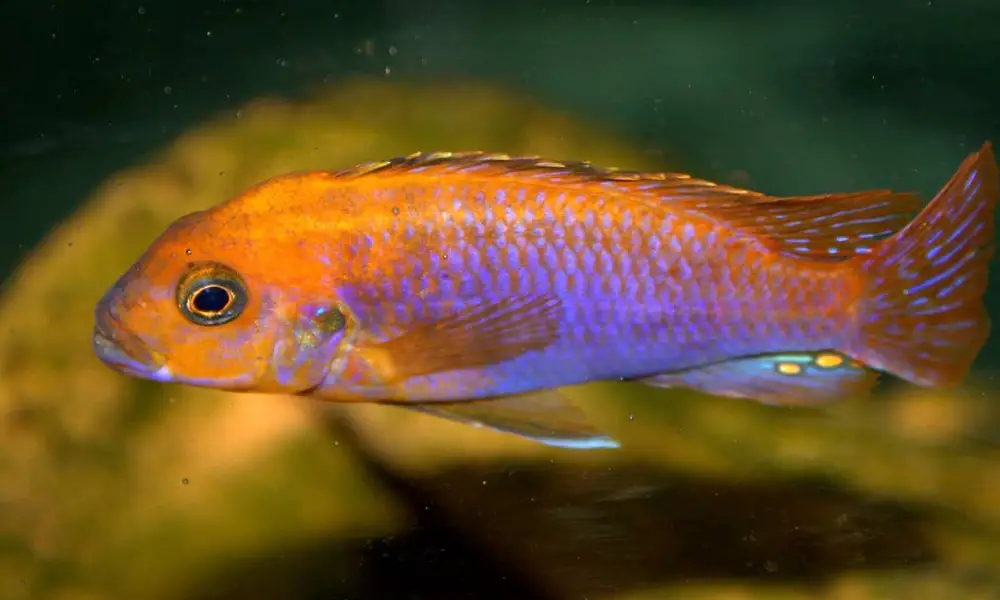
Male Rusty Cichlids (Iodotropheus sprengerae) develop a lavender purple hue when mature, while juveniles and females have a rusty brown body with faint bars.
These fish are endemic to restricted sediment-free islands and reefs in southeastern Lake Malawi. It belongs to the genus Iodotropheus and is the most common species in the trade.
Like the Yellow Tail Acei Cichlid, this fish is considered the “peaceful” mbuna cichlid, making them a perfect choice for many aquarists who just want a purple cichlid that isn’t too aggressive.
However, as with all mbunas, be sure to provide plenty of hiding places and rockwork to help them feel secure. I highly recommend using a black substrate and background to bring out their colors.
| Scientific Name: | Iodotropheus sprengeraeacus |
| Common Name: | Rusty Cichlid, Lavender Cichlid, or Lavender Mbuna |
| Care Level: | Beginner |
| IUCN Red List: | Near Threatened |
| Origin: | Lake Malawi, African |
| Lifespan: | 5 – 8 years |
| Max Size: | 4 inches (10 cm) |
| Temperature: | 76°F to 80°F |
| PH: | 7.5 to 8.8 |
| Water hardness: | 10 to 25 KH |
| Diet: | Omnivorous |
| Minimum Tank Size: | 40 gallons breeder (36″ x 18″ x 16″) |
| Temperament: | Relatively Peaceful |
Male Red Top Hongi (Labidochromis sp. “Hongi”)
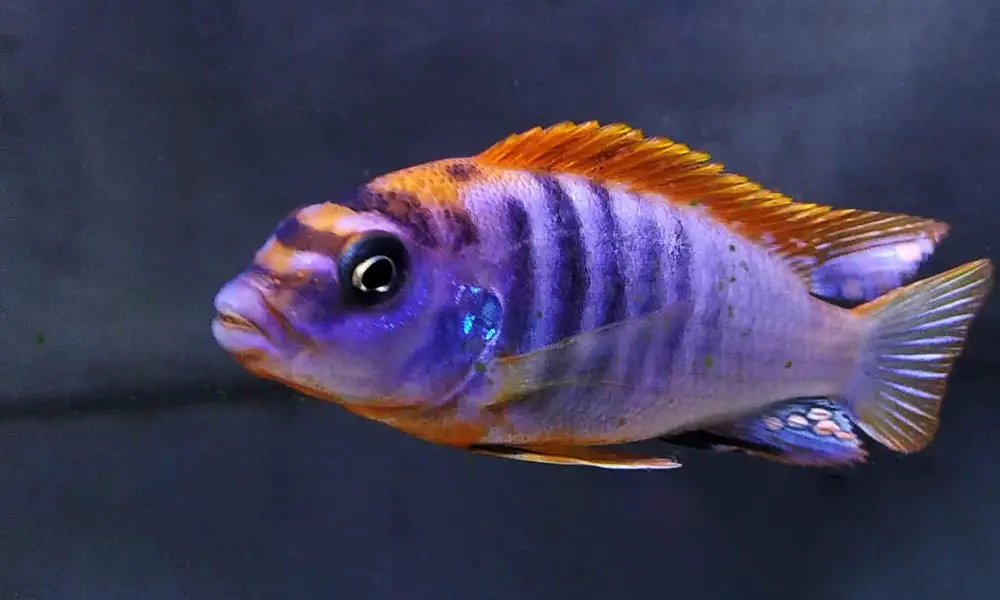
Moving on. A dominant male Red Top Hongi can show different coloration depending on its mood. They have a stunning dorsal fin that’s usually covered in colors from yellow to orange.
However, only subdominant males and females display a drab brownish-purple base with bright yellow markers. When they are ready to mate, their purple coloration will change to gorgeous lilacs, complemented with prominent dark stripes.
A hierarchy is formed among females, and it’s common to see aggression from the top female towards those lower in the order. Dominant males are aggressive towards one another, so only keep one per tank in a smaller tank. Suitable tank mates would be other moderately aggressive mbunas.
| Scientific Name: | Labidochromis sp. “Hongi” |
| Common Name: | Red Top Hongi |
| Care Level: | Beginner |
| Origin: | Lake Malawi, African |
| Lifespan: | 5 – 8 years |
| Max Size: | 6 inches (15 cm) |
| Temperature: | 76°F to 80°F |
| PH: | 7.5 to 8.4 |
| Water hardness: | 0 to 25 KH |
| Diet: | Herbivorous |
| Minimum Tank Size: | 55 gallons (48″ x 13″ x 21″) |
| Temperament: | Aggressive |
Dogtooth Cichlid( Cynotilapia Afra ‘Purple Lupingu’ )
Cynotilapia Afra, or the Dogtooth Cichlid, is one of the most popular Lake Malawia fish among Cichlid keepers owe to their various beautiful color patterns. It gets its name from the unicuspid, cone-shaped sharp teeth. These fish come with several natural color variations and can also change color depending on mood.
The purple variety is native to the Lupingu in Northern Lake Malawi. It is one of the few Dogtooth cichlids that does not have an extensive background in blue, making it a perfect candidate.
Most color morphs have darker vertical bars, but they will disappear and reappear quicker than depending on the fish’s mood and environment.
The Dogtooth Cichlid is an aggressive and territorial fish that should only be kept in a species-only or mixed moderately aggressive mbuna tank.
Male Sulfurhead Peacock (Aulonocara maylandi)
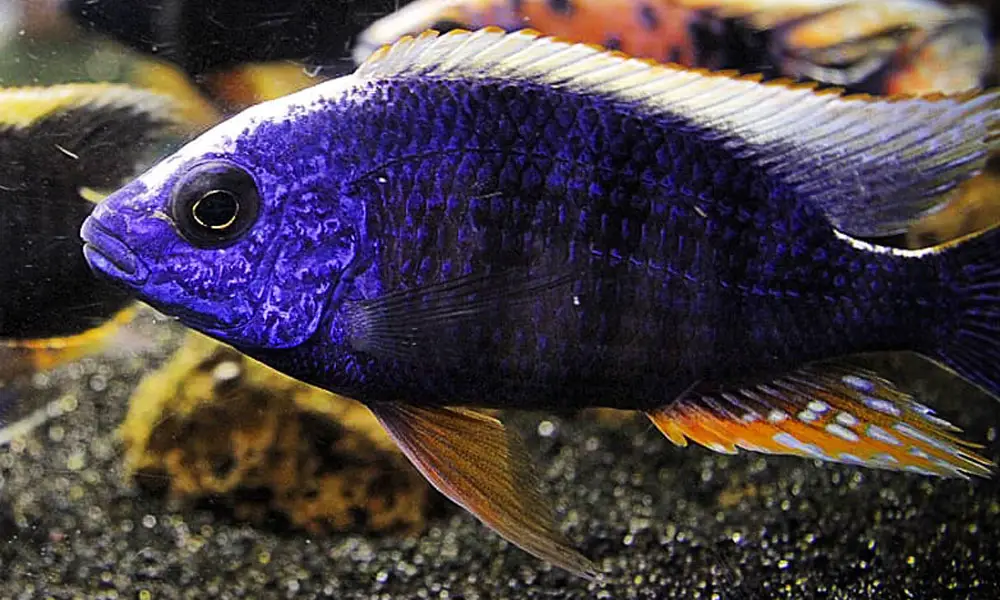
The male Sulfurhead peacocks are aptly named after the iconic yellow blaze covering their head and dorsal fin. They have dark stripes run laterally on the unique black body. The mature male exhibits a dark purple base when ready to breed.
This fish is among the most peaceful and shy of the Aulonocara species. They are best kept in a harem of one male with several females in a species only tank. Having more than one male is possible with ample space.
| Scientific Name: | Aulonocara maylandi |
| Common Name: | Sulfurhead Peacock |
| Origin: | Lake Malawi, African |
| Lifespan: | 5 – 8 years |
| Max Size: | 4.5 inches (11.4 cm) |
| Temperature: | 76°F to 82°F |
| PH: | 7.5 to 8.4 |
| Water hardness: | 0 to 25 KH |
| Diet: | Carnivorous |
| Minimum Tank Size: | 55 gallons (48″ x 13″ x 21″) |
| Temperament: | Aggressive |
Purple Rainbow (Tropheus moorii “Lufubu”)
The Blunthead Cichlid is the champion when it comes to variety. This fish can be found in every color of the rainbow with around 40 different color morphs and over 120 known variations; The purple Lufubu is one of the most vibrant and charming.
Its common name Purple Rainbow comes from the purple sheen on the dorsal fin that reflects off its body in certain lighting.
Unfortunately, these fish are not easy to keep and are best left to experienced aquarists. They are very aggressive and territorial towards individuals of conspecifics and should be kept in a large group of at least 15 fish. Moreover, like all Tropheus species, these fish are very susceptible to African Bloat.
| Scientific Name: | Tropheus moorii “Lufubu” |
| Common Name: | Blunthead Cichlid, Purple Rainbow, Blunt-Headed Cichlid, Brabant Cichlid, Moorii, and Dwarf Tanganyikan Cichlid |
| Care Level: | Advanced |
| IUCN Red List: | LC |
| Origin: | Lake Tanganyika |
| Lifespan: | 5– 8 years |
| Max Size: | 5 inches (12 cm) |
| Temperature: | 73 – 81°F (23 – 27°C) |
| PH: | 8.0 to 9.5 |
| Water hardness: | 8 to 22 |
| Diet: | Herbivores |
| Minimum Tank Size: | 75 gallons (48″ x 18″ x 21″) |
| Temperament: | Aggressive |
Kribs (Pelvicachromis pulcher)
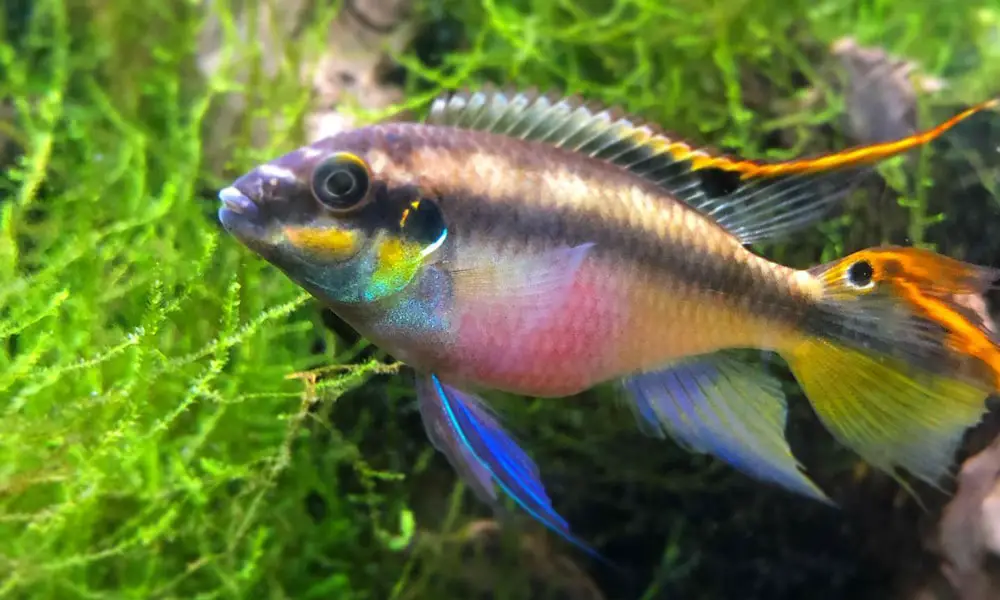
The Kribensis (Pelvicachromis pulcher), otherwise known as pink Krib or Purple cichlid, is one of the first West African cichlids introduced to the hobby. It’s easily recognizable by its purple body and orange fins. There are a few color variants available, but red and yellow variants are by far the most popular.
Unlike other fish on the list, the female Kribs are more colorful than the males. They have a characteristic purple or red belly when spawning. On the lower side of their body, you’ll also find delicate iridescent speckles that shimmer from lavender to deep violet.
Kribs are peaceful cichlids that can be kept in a community tank danios, cory cats, plecos, barbs, and these Lake Tanganyika catfish. They are relatively easy to care for and breed, making them a perfect choice for beginners. This fish is also widely available in LFS and online at a reasonable price.
| Scientific Name: | Pelvicachromis pulcher |
| Common Name: | Krib, Common Krib, red Krib, super-red Krib and rainbow Krib, purple cichlid |
| Origin: | West African |
| Size: | 4 inches |
| Care: | Beginner |
| pH: | 5.0-7.5 |
| Temperature: | 75-81°F (24-27°C) |
| KH: | 0 – 12 dKH |
| Lifespan: | 5 years |
| Diet: | Omnivore |
| Temperament: | Peaceful |
South & Central American Purple Cichlids
Almost vivid South & Central American cichlids are hybridized in captivity because they are pretty easy to hybridize with any other. The purple hue is not often found in the wild and is mostly the result of being selectively bred.
Purple Rose Queen Cichlid
The Purple Rose Queen cichlid is a purple-hued hybrid resulting from cross-breeding a species in Amphilophus (more likely A. citrinellus or A. labiatus) with a Vieja species (V. synspilum or V. bifasciatum).
This fish has an attractive appearance with overall pale pink or hot pink coloration that stands out in any community tank. Generally, they are sold in pale pink, but with color enhancing diet and proper lighting, you can bring out the purple rose hue in your fish.
The Purple Rose Queen Cichlid is one of the most sought-after hybrids in the trade and is sometimes available in specialized breeders. They are relatively costly; make sure you get the real thing and not a look-alike!
Purple Jellybean Parrot Cichlid
Unlike the True Parrot Cichlid (Hoplarchus Psittacus), the Blood Parrot is a fascinating artificial hybrid species that does not exist in the wild.
Possibly developed by crossing two well-known cichlids: the red devil cichlid (A. labiatus ) and the Severum cichlid (H. severus).
The Blood Parrot Cichlid(Purple Parrot) is not purple but takes on deep red coloration. While the purple Jellybean Parrot Cichlids, also known as Bubble Gum Parrots, are dyed fish. Their origins are unknown, but they are thought to be purple-dyed albino Blood Parrots. Different morphs are available, such as pink, blue, and other colors.
Given the fact that they are “painted” with a dye, the blotchy skin color will fade over time. On the other hand, dyed fish generally have health problems and a shorter lifespan. Therefore, we do not recommend buying these fish.

Purple Flowerhorn Cichlid
The Flowerhorn Cichlid is a man-made hybrid species developed in Malaysia and Taiwan in the 1990s. It was first created by crossing the Trimac Cichlid (Cichlasoma trimaculatum) and other South American Cichlids. They are fish are extremely unique ornamental aquarium fish that are beloved by fishkeepers all over the world.
Flowerhorns come in a wide variety of colors and patterns, but the purple color morph is rare and highly coveted by Flowerhorn enthusiasts. It was possibly produced by crossing a purple King Kong parrot and Blue Texas Cichlid.
These fish are hybrids. They can be quite aggressive and territorial. As a centerpiece fish, this beauty will be quite happy as a single specimen in a large tank.
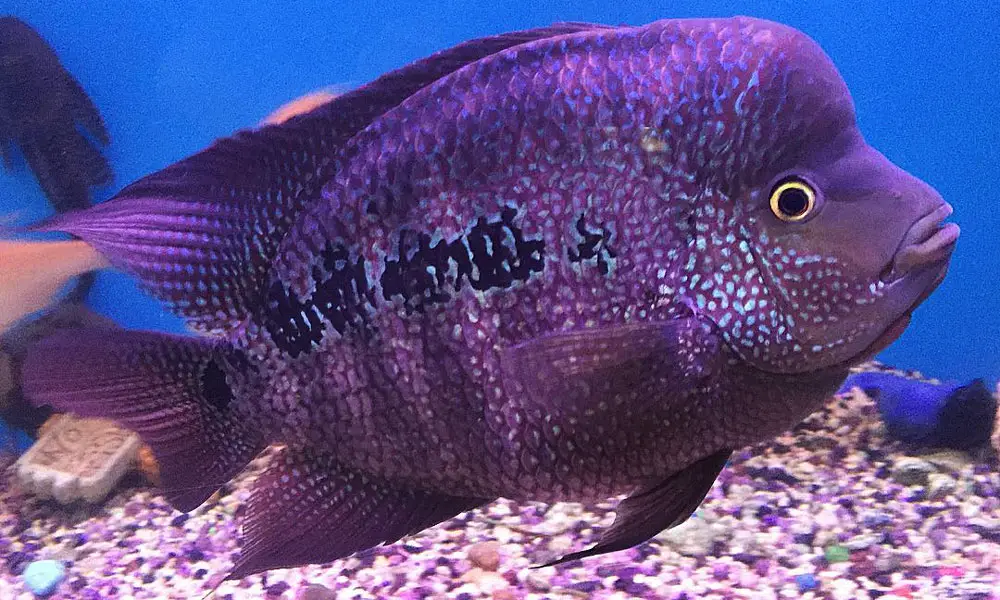
Decision Time
And that’s it for purple cichlids! These beautiful fish come in various shapes and sizes and make a great addition to any cichlid aquarium.
If you are just getting into cichlids and looking for your first purple cichlids, Kribs and Yellow Tail Aceis are good starting fish. For something a little more unusual, check out the Purple Rose Queen or Purple Lupingu Afra.
Do you have a favorite purple cichlid you think we should add to this list? Let us know in the comments below!
